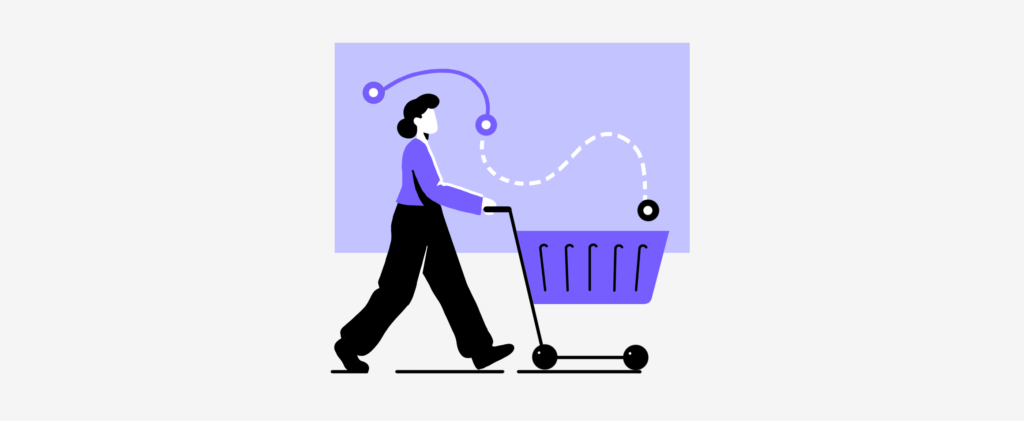Chances are you’ve come across the concept of “customer journey mapping.” It’s a widely recognized and valuable tool utilized in marketing and sales strategies. It is used to gain insights into the customer experience and enhance it accordingly. But what exactly does it consist of?
Customer journey mapping involves the process of visually illustrating every touchpoint and interaction a customer has with your business, from the initial awareness stage through the purchase and post-purchase stages.
By mapping out this journey, you can identify pain points, areas for improvement, and opportunities to deliver exceptional experiences at every step.
So, if you haven’t explored the power of customer journey mapping yet, it’s time to dive in and unlock the potential of your business!
What Is a Customer Journey?
A customer journey is the entire process that a buyer goes through when interacting with your brand, from the initial awareness to the final purchase and beyond. It includes all touchpoints, both online and offline, that a customer may encounter along the way.
A customer journey is sometimes called a buyer journey. So, if you’re wondering what the difference is between a buyer journey vs. a customer journey, now you know that it’s basically the same thing.
There are five main buyer journey stages:
Awareness: the customer becomes aware of your brand and what you have to offer. Consideration: the customer starts researching and comparing different options. Purchase: the customer decides to make a purchase from your brand. Retention: keeping the customer satisfied and coming back for repeat business. Advocacy: the customer becomes a loyal fan and promotes the business to their friends and family.
At each stage, the customer’s emotions, motivations, and behaviors may differ, making it crucial to understand their journey to engage with them effectively.
B2B Buyer Journey VS B2C Buyer Journey
You might wonder how the business-to-business buyer journey differs from the business-to-consumer buyer journey. While many of the general principles and touchpoints are similar, there are some key differences to keep in mind.
Firstly, B2B buyers often have a longer and more complex purchasing process than B2C consumers. This is because B2B purchases typically involve larger amounts of money and require multiple decision-makers within the organization.
Additionally, B2B buyers tend to focus more on finding solutions that will benefit their business in terms of efficiency, cost savings, or growth potential. They may also prioritize building long-term relationships with vendors rather than one-time transactions.
On the other hand, B2C buyers are usually motivated by personal needs or desires when making a purchase. Their journey tends to be shorter and simpler as they make decisions based on factors like price, convenience, and emotional appeal.
What Is Buyer Journey Mapping?
Buyer journey mapping is the process of visually representing the steps a customer takes when interacting with your business, from initial contact to post-purchase. It helps identify touchpoints and pain points, allowing you to better understand the customer experience and make improvements.
Mapping your buyer’s journey can be an incredibly powerful tool for improving your business’s overall success. However, there are certain dos and don’ts to keep in mind.
How to Map Your Customer Journey
You can’t improve something if you don’t have it. So, if you’ve never created a customer journey map, it’s time to do so.
Here are some best practices for mapping your customer’s journey:
Create Your Buyer Persona
To map the customer’s journey, you need to research and analyze your customers’ behaviors, motivations, and pain points. That’s where buyer personas come in handy.
A buyer persona is a fictional customer that embodies the demographics and psychographics of your average customer. This customer persona serves as a constant reminder to align every aspect of your customer journey map with the right audience.
Identify your customers’ needs, motivations, and pain points to create your buyer persona (Image: Wordstream)
For example, if you sell high-end skincare products, your customer persona might be a 35-year-old woman with a full-time job and two kids who values self-care and luxury. This specific persona will give you insights into her needs, challenges, and goals.
It would help to conduct some user research when creating your buyer persona. For example, you can survey customers and take interviews.
To gather feedback from consumers who are interested in buying your products and services, target those who have either engaged with your company or are intending to do so. This way, you can get accurate information about your target audience’s needs and preferences.
Identify Your Touchpoints
Next, you’ll need to identify all the touchpoints where customers interact with your brand. To do this, put yourself in your customer’s shoes and think about every possible way they could come across or engage with your business.
99% of consumers research purchases online before going to a store, at least most of the time. So, it’s pretty likely that your consumers do some online research, too. However, don’t forget to use the data from your customer and market research. This will provide you with a list of all the touchpoints your customers use.
For example, your customer’s touchpoints online may include:
Searching for products on Google Visiting your website Reading reviews on social media Seeing your Facebook ads.
As for an offline customer touchpoint, this can include:
Visiting your physical store Visiting your booth at a market or event Calling your customer service.
Remember that each touchpoint should be evaluated based on its impact and importance to the overall customer journey.
Identify Pain Points and Opportunities
Once you have identified all the touchpoints, it’s time to look for pain points and opportunities for each of them. This involves analyzing customer feedback and complaints and using behavior analytics tools to identify areas where your brand can improve and provide a better experience.
For example, if you notice many website visitors dropping off at the checkout page, they could be facing a pain point that needs to be addressed as soon as possible. If you also see a surge in customer queries on social media but slow response times from your customer service team, this could be another area of improvement.
Document the Customer Journey
Once you have identified all the touchpoints, it’s time to put them in order and map out the customer journey. Start with the awareness stage and document each step until they become a loyal customer.
Make sure to include the emotions, behaviors, and motivations at each stage. This will give you a clear understanding of how your customers feel and what they need at each step of the journey.
The process of mapping the customer journey remains speculative until you actually implement it. By doing so, you will gain firsthand insights into potential drop-offs or obstacles that customers may encounter along their journey. If you have multiple personas, follow the journey for each of them.
Continuously Review and Improve
Remember that the customer journey is not static — it’s constantly evolving. That’s why it’s essential to review and improve your customer journey map continuously. This can involve conducting regular customer surveys, analyzing data, and making necessary adjustments to ensure a seamless customer experience.
Reviewing your customer journey regularly, for example, quarterly, will help you identify gaps and opportunities for further improving your customer journey.
Customer Journey Mapping Examples
To help you better understand the concept, let’s look at some customer journey map examples from various industries.
Customer Journey Map Example for Retail
A customer journey map for a retail store encompasses various touchpoints that customers encounter during their shopping experience. These customer touchpoints may include browsing products online, visiting the physical store, exploring different sections, trying on clothes in the fitting rooms, and finally making a purchase.
Throughout this journey, customers can have both positive and negative experiences. Pain points could arise from encountering long checkout lines or interacting with unfriendly staff members, while positive aspects could include finding helpful product recommendations, receiving excellent customer service, or discovering personalized offers tailored to their preferences.
Customer Journey Map Example for Travel
For a travel company, the customer journey begins with researching destinations, where customers explore different options and gather information to make informed decisions.
Once the desired destination is chosen, the next step involves booking flights and accommodations, ensuring that every part of the trip is well-planned and tailored to the customer’s preferences.
Finally, the journey concludes with the check-in process, where travelers go through the necessary procedures to get to their destination.
Along this journey, there may be pain points that travelers encounter. These could include limited flight options, restricting flexibility and convenience, or unexpected delays that disrupt travel plans.
Customer Journey Map Example for Banking
A bank’s customer journey encompasses a series of touchpoints that customers encounter throughout their banking experience. These customer touchpoints could include activities such as opening an account online, visiting a branch for in-person assistance, and utilizing mobile banking services for convenient transactions.
However, it is important to identify and address potential pain points that customers may encounter during these touchpoints. For example, pain points could arise from complicated online account setup processes or long wait times experienced at the branch.
As you can see, each industry may have different touchpoints and pain points. That’s why it’s essential to create an accurate customer journey map specific to your business and continuously improve it based on data and customer feedback.
Of course, our examples are quite simplified versions of customer journey maps. Ideally, your customer journey map should be detailed and consider not only the specifics of your business but also different target customer personas.
To make it easier to map your customer journey, you can use templates — learn more about that below.
Dos and Don’ts of Mapping Your Customer Journey
Now that you’ve grasped the idea of customer journey mapping, let’s dive into the do’s and don’ts to remember when creating your map.
Do: Choose the Right Customer Journey Map Templates
Templates can be a helpful tool in creating your customer journey map. They provide a visual representation of the customer journey and make it easier to identify pain points and opportunities.
There are various templates available for creating a customer journey map. They differ in complexity, design, and approach. Some customer journey templates are better for visualizing a customer’s emotions, while others focus on touchpoints and pain points. It’s crucial to choose a template that best suits your business needs and goals.
Here are a few examples of common customer journey map templates:
Current State Customer Journey Map Template
This is one of the most common types of customer journey maps. They help you see and understand what your customers are going through — their actions, thoughts, and emotions when they interact with your company. This valuable insight is used to enhance the customer journey continuously.
Download a current state customer experience map template here.
Day-in-the-Life Customer Journey Map Template
These customer journey maps show what your customers go through in their daily activities, including their actions, thoughts, and emotions, whether or not they involve your brand and more. This type of customer journey map provides a broader perspective into your customers’ lives and helps identify their real-life pain points.
Day-in-the-life customer journey maps are great for addressing unmet customer needs even before they are aware of them. Use this type of map when exploring new market development strategies.
Here’s a visual representation and a template for day-in-the-life customer journeys.
Future State Customer Journey Map Template
These customer journey maps provide insights into the actions, thoughts, and emotions that your customers will experience during their future interactions with your company. When using this customer journey map, consider their current interactions with your brand.
Use these types of customer journey maps to visualize your vision and establish strategic goals that drive your business forward.
Here’s a future state example of customer journey map templates.
Service Blueprint Customer Journey Map Template
These customer journey maps start with a simplified version of one of the map styles mentioned above. They then add the key elements that contribute to delivering a remarkable experience, such as people, policies, technologies, and processes. These maps provide valuable insights into optimizing customer experiences and enhancing overall satisfaction.
Service blueprints help uncover the factors driving current customer journeys and map out steps for future journeys. This will help you make informed decisions to enhance your offerings.
You can download a service blueprint template here.
Do: Test Customer Journey Mapping Tools
There are several digital tools out there to help you create a customer journey map. These tools can make the process more efficient and effective by allowing you to collaborate with your team easily, customize your map, and integrate data.
Some popular customer journey mapping tools include:
UXPressia
This tool includes various templates for different industries, making it easier to start mapping your customer journey right away.
You can search for the template you need on UXPressia website
Smaply
This tool offers a user-friendly interface for creating different types of maps, including service blueprints and customizable customer and user journey maps.
Custellence
This customer journey mapping software helps teams create visual representations of customer journeys. It offers various templates and collaboration features.
Lucidchart
This is a popular diagramming and visualization tool that includes a customer journey mapping feature. It comes with built-in collaboration features.
Creating a customer journey map in Lucidchart
Whichever tool you choose, make sure it fits your specific needs and helps you create a detailed and effective customer journey map.
Don’t: Neglect Customer Feedback
One of the biggest mistakes in customer journey mapping is not taking customer feedback into consideration. Your customers’ opinions and experiences are crucial in understanding their needs, emotions, and expectations throughout their journey with your brand.
Make sure to regularly collect customer feedback through surveys, reviews, and other channels. Use this information to update and improve your customer journey map continuously.
Don’t: Rush the Process
Mapping a customer journey takes time and effort. It’s crucial not to rush through the process or skip important steps. Take the time to thoroughly research and gather data, analyze it, and collaborate with other team members to create an accurate and comprehensive customer journey map.
Don’t: Forget to Update
A customer journey map is not a one-time task. It is an ongoing process that requires continuous effort and attention.
As your business evolves and customer behavior changes, it’s essential to regularly update and revise your customer journey map to reflect these changes accurately. By doing so, you can ensure that it remains relevant and effective in guiding your business towards providing exceptional customer experiences.
Remember, a well-crafted customer journey map goes beyond just visualizing the customer’s interactions. It serves as a strategic tool that helps align your team’s efforts, foster collaboration across departments, and prioritize initiatives that will have the most significant impact on customer satisfaction and loyalty.
So, embrace the concept of continuous improvement and make updating and revising your customer journey map a regular part of your business practices. By doing so, you can ensure that your organization stays ahead of the curve.
Let’s Sum Up Mapping Your Buyer Journey
Now, let’s sum up the main do’s and don’ts of mapping your buyer journey:
Do use different types of customer journey maps to gain a comprehensive understanding of your customers. Do consider using tools to make the process more efficient and effective. Don’t neglect customer feedback, as it is crucial in understanding their needs and expectations. Don’t rush the process or skip important steps. Don’t forget to update and revise your customer journey map regularly.
By keeping these tips in mind, you can create a detailed and accurate customer journey map to help your business thrive by providing exceptional customer experiences.
5 Effective “Buy One, Get One Free” Promotions 17 Tips to Increase Conversion Rate and Drive More Sales 14 Psychological Triggers That Will Win Over Customers 12 Ways to Inspire Confidence In Your New Customers 10 Actionable Ways to Increase Your Ecommerce Revenue How To Boost Conversion with Automated Discounts Examples of Awesome Call to Action That Sell How to Increase Sales by Improving Customer Journey in Ecommerce Dos and Don’ts of Mapping Your Buyer Journey
The post Dos and Don’ts of Mapping Your Buyer Journey first appeared on Ecwid | E-Commerce Shopping Cart.





